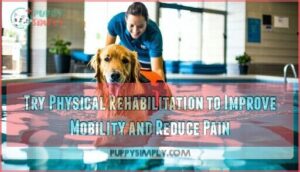This site is supported by our readers. We may earn a commission, at no cost to you, if you purchase through links.
 To help a dog with arthritis at home, focus on comfort and joint support.
To help a dog with arthritis at home, focus on comfort and joint support.
Invest in an orthopedic bed to ease pressure on sore joints, and scatter non-slip mats to prevent slipping.
Keep their weight in check—it’s like carrying a lighter backpack on a long hike.
Feed them a balanced diet, and consider adding joint supplements or omega-3-rich treats like fish.
Moderate exercise, like short walks, keeps joints moving without overloading them.
Use ramps for easier access to furniture or cars, and avoid activities that make them strain.
Sometimes, it’s the little changes that make tails wag again, and providing joint support can significantly improve their quality of life.
Table Of Contents
- Key Takeaways
- Helping Dogs With Arthritis
- Helping a Dog With Arthritis at Home
- Managing Arthritis Symptoms
- Creating a Comfortable Environment
- Improving Quality of Life
- Use Non-Slip Flooring or Mats to Prevent Slipping and Sliding
- Provide Orthopedic Beds With Memory Foam for Better Weight Distribution
- Assist With Furniture and Car Access Using Ramps or Steps
- Maintain a Healthy Lifestyle to Support Overall Joint Health
- Consult With a Veterinarian to Develop a Comprehensive Care Plan
- Frequently Asked Questions (FAQs)
- How can I Help my Dog with arthritis?
- What is canine arthritis?
- Is arthritis painful for dogs?
- How can weight loss help a dog with arthritis?
- Does walking help a dog with arthritis?
- How do I protect my arthritic dog?
- What is the best treatment for arthritis in dogs?
- How to strengthen dog back legs arthritis?
- What is the best diet for a dog with arthritis?
- What exercise can I do with my dog to help ease the pain of arthritis?
- Conclusion
Key Takeaways
- Keep your dog comfortable with non-slip mats, ramps, and an orthopedic memory foam bed to ease joint strain.
- Maintain a healthy weight and feed a balanced diet rich in omega-3s to reduce inflammation and joint stress.
- Provide low-impact activities like short walks or swimming to keep joints moving without overloading them.
- Partner with your vet to create a care plan, including joint supplements and pain relief options.
Helping Dogs With Arthritis
Helping your dog with arthritis starts by understanding their pain and adjusting their daily routine to make life easier.
Understanding your dog’s arthritis pain is the first step to improving their comfort and bringing wagging tails back.
With a few simple changes at home, you can keep their joints happy and their tail wagging.
Difficulty Standing Up or Lying Down
Morning stiffness can make standing up or lying down tough for dogs with arthritis.
Muscle weakness and joint pain often slow mobility.
To ease this, consider assistive devices or a bed design with memory foam for comfort.
These simple dog arthritis home care tips can provide dog arthritis pain relief while managing dog arthritis effectively at home.
Slowing Down or Reluctance to Exercise
If your dog is slowing down, it’s not just old age—it could signal arthritis pain.
Exercise reluctance causes mobility issues to worsen without early intervention.
Use pain assessment tools and switch to modified exercise plans like low-impact walks or swimming.
Alternative activities, like scent games, keep your canine active without strain, and you should tailor dog arthritis exercise routines to their comfort.
Reduced Interest in Activities They Usually Enjoy
A once playful pup may show lost enthusiasm for activities they adored, like fetch or tug-of-war.
This playtime decline can hint at mobility issues or discomfort.
To rekindle joy:
- Explore gentle games suited to their abilities.
- Offer interactive toys to keep them engaged.
- Observe appetite changes and sleep patterns for clues about dog arthritis pain management or needed home remedies.
The goal is to identify potential issues, such as mobility issues, and address them to improve the pup’s quality of life.
Increased Irritability or Reactivity Due to Pain
Ever notice how your dog seems grumpier than usual? Arthritis pain can lead to reduced patience and even touch sensitivity.
Dogs might show pain-related aggression or other behavioral changes. To help, practice gentle handling precautions and focus on canine pain relief.
Here’s a quick table on signs to watch for:
| Symptom | What It Means | What to Do |
|---|---|---|
| Growling or Snapping | Pain-related aggression | Avoid pressure points, handle gently |
| Flinching When Touched | Touch sensitivity | Use calm, soothing strokes |
| Avoidance and Withdrawal | Behavioral changes, chronic pain | Consult your vet for pain management |
Helping a Dog With Arthritis at Home
When your furry friend struggles with arthritis, small changes at home can make a big difference.
Small adjustments at home can transform your dog’s life, easing arthritis pain and keeping their tail wagging.
Start by creating an environment that supports their needs—think simple but effective home adaptations.
- Lay down non-slip rugs or mats to prevent your dog from slipping; tile or hardwood floors can be tough on aching joints.
- Use an assistive device DIY, like a homemade ramp or steps, to help them access the couch or car without straining.
- Offer a comfortable dog bed designed for arthritis, such as one with memory foam, to ease pressure on sore joints.
These small efforts aren’t just about comfort—they’re acts of emotional support, showing your dog how much you care.
Remember, even a little help can go a long way.
For example, consider gentle stretches benefit arthritic dogs.
Managing Arthritis Symptoms
You can make a big difference in managing your dog’s arthritis by focusing on simple adjustments to their daily routine.
By being consistent and thoughtful, you’ll help reduce their discomfort and keep them feeling as happy as possible, which can be achieved through simple adjustments.
Incorporate Morning Oily Fish Treats
Adding oily fish to your dog’s morning routine is a simple, tasty way to ease arthritis pain.
Fish like salmon or sardines are rich omega-3 sources, reducing inflammation and supporting joint lubrication.
Use plain, water-packed fish—skip spices or tomato sauce.
A small daily dosage as part of their arthritis dog diet can boost mobility and comfort.
Many owners find specialty oily fish products beneficial, which can be a great addition to their daily routine.
Disable Your Doorbell to Prevent Sudden Movements
Dogs with arthritis might rush to the door when the bell rings, worsening joint pain due to sudden movements.
Silencing the doorbell minimizes noise sensitivity and helps with joint protection. Instead, let visitors text or knock quietly.
This simple environmental modification is an effective home remedy for dog arthritis, promoting dog comfort and better management of triggers at home.
Home modifications like this, along with orthopedic dog beds, can substantially improve an arthritic dog’s quality of life, providing a more comfortable living space through environmental modification.
Turn on a T.V or Radio When You Leave to Mask External Noises
When leaving home, play calming sounds like classical music or low-volume TV to provide auditory enrichment.
This sound masking reduces startles from external noises, easing noise anxiety for dogs with arthritis.
It’s a simple home care tip for arthritis management, creating dog comfort while ensuring stress doesn’t aggravate their condition.
Keep the volume gentle for effective arthritis management.
Limit Mobility Commands to Only When Necessary
Reducing command frequency can help protect your dog’s joints and ease discomfort. Pain awareness is key—avoid commands that force unnecessary movement.
- Skip commands like "sit" if standing causes strain.
- Use movement alternatives, such as guiding instead of calling.
- Prioritize mental stimulation over physical tasks.
- Keep high-energy cues for emergencies.
- Choose home care strategies over excessive mobility demands.
To implement these strategies effectively, consider the overall well-being of your dog, focusing on joint protection and minimizing strain.
Provide a Dog Bed in Every Room Where Family Spends Time
A comfortable dog bed in every room guarantees joint pressure relief and keeps your arthritic dog socially included.
Think of it as giving them front-row seats to family life.
Orthopedic beds reduce strain on protruding joints, making movement less painful.
Choose spots where you gather most—living room, bedroom, kitchen—so they’re always part of the action.
Providing a dog with a supportive orthopedic bed can substantially improve their comfort.
| Benefit | How It Helps | Emotional Impact |
|---|---|---|
| Joint Pressure Relief | Supports aching, stiff joints | Reduces visible discomfort |
| Bed Placement Strategy | Ensures nearby access to comfort | Lessens worry for pet owners |
| Social Inclusion | Keeps them close to family activity | Boosts pet’s mood and connection |
| Comfort Everywhere | Eases everyday pains effectively | Promotes relaxation and happiness |
| Protruding Joints | Prevents pressure build-up | Adds peace for both pet and owner |
The benefits of orthopedic beds for dogs are numerous, including reducing strain on joints and promoting a sense of inclusion.
By placing these beds in strategic locations, you can ensure your dog is always part of the action, which can have a positive impact on their emotional well-being.
Creating a Comfortable Environment
Making your home arthritis-friendly can greatly improve your dog’s comfort and mobility.
Simple changes like adding soft bedding and preventing slippery floors will help protect their joints while keeping them happy.
Keep Your Dog at a Healthy Weight to Reduce Joint Strain
Managing your dog’s weight isn’t just about looks—it’s about comfort.
Extra pounds put stress on arthritic joints, making movement harder.
Focus on weight management through a balanced diet and low-impact exercise.
If weight loss feels tricky, consult your vet to check for metabolic conditions.
Remember, healthy weight equals happy joints, and a dog that lingers near their bowl needs your watchful eye!
Get Your Dog on a Proper Diet to Support Joint Health
A balanced diet is your dog’s first defense against arthritis pain.
Focus on weight management and foods rich in omega-3 fatty acids like salmon to reduce inflammation.
Include high-quality animal protein for muscle health and add glucosamine and chondroitin through commercial dog arthritis diets.
Don’t forget hydration—it keeps joints lubricated and your dog moving comfortably!
Try Joint Supplements to Support Cartilage Health
Did you know joint supplements can help ease your dog’s arthritis pain?
Options like glucosamine for dogs and chondroitin for dogs support cartilage health, reducing stiffness and discomfort.
Always check supplement regulation and follow dosage guidelines from your vet.
Early supplementation, combined with therapies, boosts effectiveness.
Omega-3 fatty acids can further reduce inflammation.
Dog arthritis supplements offer real relief—your pup deserves the best care!
Include Light Exercise to Maintain Joint Mobility
Some light canine exercise can work wonders for arthritic joints.
Controlled walks on soft surfaces are ideal, while range-of-motion exercises and gentle stretching help maintain flexibility.
Water exercise, like swimming, gives joint-friendly support.
Low-impact routines, such as scent work, keep your dog’s mind and body active.
Always tailor dog arthritis exercise routines to their comfort level and consult your vet to ensure the best approach for your dog’s specific needs, using gentle stretching.
Try Physical Rehabilitation to Improve Mobility and Reduce Pain
Physical rehabilitation can work wonders for dogs with arthritis.
Here are ways to help:
- Try hydrotherapy – swimming or underwater treadmills improve mobility while reducing joint strain.
- Use massage techniques to ease pain and tension.
- Explore laser therapy for inflammation relief and tissue healing.
- Consult a vet about acupuncture efficacy for long-term mobility support.
Consistent home exercises make a difference and can be a key part of a rehabilitation plan.
Improving Quality of Life
You can make life easier for your arthritic dog by focusing on simple adjustments that reduce strain and improve comfort.
With the right tools and a bit of planning, you’ll keep them moving and feeling their best.
Use Non-Slip Flooring or Mats to Prevent Slipping and Sliding
Your pup deserves safe, secure footing.
Preventing dog falls starts with nonslip flooring or mats, which reduce accidents and stress on achy joints.
Opt for grippy materials like rubber-backed rugs on hardwood or tiles.
Keep them clean with DIY non-slip solutions like vinegar spray.
Smart mat placement tips include high-traffic areas and your dog’s favorite napping spots during arthritis treatment.
Provide Orthopedic Beds With Memory Foam for Better Weight Distribution
An orthopedic bed with memory foam can make a world of difference for your arthritic dog. It evenly distributes their weight, easing pressure on sore joints.
- Choose memory foam beds with washable covers for cleaning ease.
- Opt for the right size—big enough for stretching without crowding.
- Place the bed near family spaces for comfort and companionship.
Your dog will thank you! Look for beds with durable, waterproof liners to protect against accidents.
Assist With Furniture and Car Access Using Ramps or Steps
Using ramps or pet stairs simplifies life for dogs with arthritis. Portable ramps with gentle incline angles and surface traction help them reach furniture or cars without strain.
Step alternatives are great for low heights, reducing joint stress. For dogs suffering, consider dog ramp solutions.
Ramp training guarantees your dog uses mobility aids correctly. These dog arthritis home modifications bring comfort and freedom back to daily routines.
Maintain a Healthy Lifestyle to Support Overall Joint Health
A healthy lifestyle is key to happier joints.
Focus on these three steps:
- Practice weight management—extra pounds add strain to joints.
- Follow dog arthritis dietary recommendations, like a balanced diet with omega-3s.
- Encourage low-impact exercise, such as short walks or swimming.
Small changes, like these, make a big difference in maintaining mobility for your furry companion.
Consult With a Veterinarian to Develop a Comprehensive Care Plan
Partnering with a veterinarian is like having a coach for your dog’s arthritis journey.
They’ll explain diagnosis importance while tailoring dog arthritis treatment to your pet’s needs.
From pain management plans to monitoring medication, they cover it all.
A holistic approach, mixing medical treatment and lifestyle tweaks, keeps your dog happy.
Check this table for guidance:
| Concern | Role of Vet |
|---|---|
| Diagnosis importance | Identifies arthritis early |
| Treatment options | Tailors therapies |
| Pain management | Adjusts medications |
| Medication monitoring | Guarantees safety and efficacy |
| Holistic approach | Combines treatments wisely |
Frequently Asked Questions (FAQs)
How can I Help my Dog with arthritis?
Taking a page from aging athletes, help your dog with soft bedding, ramps for furniture, non-slip rugs, and low-impact exercise.
Keep meals balanced, manage their weight, and consult your vet about joint supplements or therapies, focusing on low-impact exercise.
What is canine arthritis?
Canine arthritis is a common, progressive joint condition causing pain, stiffness, and mobility issues, especially in older dogs.
It doesn’t have a cure, but proper care and management can greatly improve your dog’s quality of life.
Is arthritis painful for dogs?
Yes, arthritis is painful for dogs.
It causes stiffness, inflammation, and aches in their joints, making movement challenging.
They might hide it well, but imagine walking with a pebble in your shoe—it’s that uncomfortable!
How can weight loss help a dog with arthritis?
Ironically, carrying extra weight weighs heavily on achy joints.
Dropping those pounds lightens the load on your dog’s joints, reducing strain, pain, and inflammation.
A leaner pup means easier movement and a happier tail wag, with less strain on their joints, making them more comfortable, which can be summarized as a happier life.
Does walking help a dog with arthritis?
Walking helps your dog stay mobile and maintain muscle.
Stick to short, gentle walks on even surfaces to avoid strain. Pay attention to their pace, and don’t overdo it.
Consistency beats marathon strolls any day!
How do I protect my arthritic dog?
Treat your arthritic dog like royalty—because they deserve it.
Add ramps, cozy orthopedic beds, non-slip mats, and raised bowls.
Keep them warm, trim their nails, and maintain a healthy weight for easier, pain-free movement.
What is the best treatment for arthritis in dogs?
The best treatment for a dog’s arthritis combines weight management, joint supplements like glucosamine, low-impact exercise, and vet-prescribed pain relief.
Include physical therapy, ramps, or orthopedic beds to improve mobility and comfort at home, which can be considered as part of joint supplements and overall care.
How to strengthen dog back legs arthritis?
Who knew your dog’s selfie days meant “sitting” would eventually need work?
Focus on low-impact exercises like water therapy or controlled walking, pair with joint-friendly foods, and add gentle massage or heat therapy for relief.
This approach helps in providing relief to your dog.
What is the best diet for a dog with arthritis?
Focus on weight control, omega-3-rich foods like salmon, and joint supplements such as glucosamine.
Avoid human NSAIDs, but consult your vet for safe options.
Balanced diets reduce inflammation and keep your pup moving comfortably with glucosamine.
What exercise can I do with my dog to help ease the pain of arthritis?
Take your dog on short, gentle walks daily, avoiding hard surfaces.
Swimming is excellent if they enjoy it, as it eases joints without weight-bearing strain.
Always watch for signs of discomfort or fatigue.
Conclusion
Caring for an arthritic dog is like giving an old engine some TLC—it may not be brand-new, but it can still run smoothly.
Small changes at home, like orthopedic beds, non-slip mats, and ramps, can ease daily struggles.
Keep their diet balanced, add joint-support supplements, and don’t skimp on light exercise to keep those joints moving.
By focusing on comfort and joint health, you’re not just managing arthritis—you’re improving their quality of life and keeping tails wagging longer.
- https://www.simonvetsurgical.com/news/how-to-manage-canine-arthritis-pain-medications-and-home-remedies
- https://www.petmd.com/dog/general-health/dog-arthritis-treatment-how-to-help-a-dog
- https://www.pdsa.org.uk/pet-help-and-advice/pet-health-hub/conditions/arthritis-in-dogs
- https://www.goodrx.com/pet-health/dog/dog-arthritis-tips-treatment-relief
- https://tploinfo.com/blog/natural-remedies-for-dog-arthritis-pain/



















